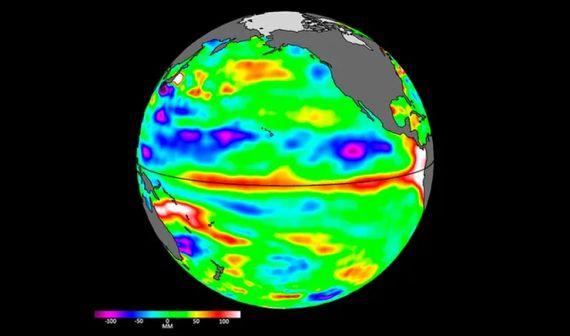NASA’s Sentinel-6 Michael Freilich satellite has detected Kelvin waves in the Pacific Ocean.
These bring warmer-than-normal water to the coasts of Peru, Ecuador, and Colombia.
The images show Kelvin waves about 5 to 10 centimeters high and hundreds of kilometers wide at the ocean surface, moving from west to east along the equator toward the west coast of South America.
As they form at the equator, Kelvin waves bring warm water associated with higher sea levels from the western Pacific to the eastern Pacific.

EARLY SIGNS OF THE EL NIÑO PHENOMENON
The series of Kelvin waves that begin at this time is a known precursor to El Niño.
Higher sea levels and warmer-than-average ocean temperatures along western coasts characterize this phenomenon.
Water expands as it warms, so sea levels are higher in places with warmer water. El Niño is also associated with a weakening of trade winds.
The latest data from the Michael Freilich Sentinel-6 satellite cover the period between early March and late April 2023.
By April 24, Kelvin waves had accumulated warmer water and higher sea levels (shown in red and white) off the coasts of Peru, Ecuador, and Colombia.
It should be noted that Peru and Ecuador have experienced an increase in ocean temperatures off their coasts since February 2023, which has driven the development of El Niño Costero, a localized phenomenon in this sector of the Pacific Ocean.
Satellites such as Sentinel-6 Michael Freilich can detect Kelvin waves with a radar altimeter that uses microwave signals to measure sea surface height.
When an altimeter passes over areas that are warmer than others, the data indicate higher sea levels.
GLOBAL WARMING AT RECORD LEVELS
“We’re going to watch this El Niño like a hawk,” said Josh Willis, Sentinel-6 Project Scientist Michael Freilich at NASA’s Jet Propulsion Laboratory in Southern California.
“If it is large, the globe will experience record warming.”
The US National Oceanic and Atmospheric Administration (NOAA) and the World Meteorological Organization have recently reported that the likelihood of an El Niño developing in late summer is increasing.
Continued monitoring of ocean conditions in the Pacific by instruments and satellites such as Sentinel-6 Michael Freilich should help clarify how strong it could become in the coming months.
“When we measure sea level from space using satellite altimeters, we know not only the shape and height of the water but also its motion, such as Kelvin and other waves,” explained Nadya Vinogradova Shiffer, NASA program scientist, and director of Sentinel-6 Michael Freilich in Washington.
“Ocean waves conduct heat around the planet, bringing heat and moisture to our shores and changing our climate.”
News Latin America, English news Latin America, Climate, NASA

